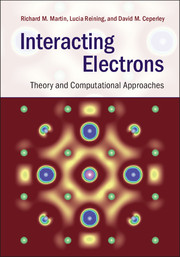Book contents
Preface
Published online by Cambridge University Press: 05 June 2016
Summary
Recent progress in the theory and computation of electronic structure is bringing an unprecedented level of capability for research. It is now possible to make quantitative calculations and provide novel understanding of natural and man-made materials and phenomena vital to physics, chemistry, materials science, as well as many other fields. Electronic structure is indeed an active, growing field with enormous impact, as illustrated by the more than 10,000 papers per year.
Much of our understanding is based on mean-field models of independent electrons, such as Hartree–Fock and other approximations, or density functional theory. The latter is designed to treat ground-state properties of the interacting-electron system, but it is often also used to describe excited states in an independent-electron interpretation. Such approaches can only go so far; many of the most interesting properties of materials are a result of interaction between electrons that cannot be explained by independent-electron descriptions. Calculations for interacting electrons are much more challenging than those of independent electrons. However, thanks to developments in theory and methods based on fundamental equations, and thanks to improved computational hardware, many-body methods are increasingly essential tools for a broad range of applications. With the present book, we aim to explain the many-body concepts and computational methods that are needed for the reader to enter the field, understand the methods, and gain a broad perspective that will enable him or her to participate in new developments.
What sets this book apart from others in the field? Which criteria determine the topics included? We want the description to be broad and general, in order to reflect the richness of the field, the generality of the underlying theories, and the wide range of potential applications. The aim is to describe matter all the way from isolated molecules to extended systems. The methods must be capable of computing a wide range of properties of diverse materials, and have promise for exciting future applications. Finally, practical computational methods are an important focus for this book.
Choices have to be made since the number of different approaches, their variations, and applications is immense, and the book is meant to be more than an overview. We therefore cannot focus on such important areas as quantum chemistry methods, e.g. coupled cluster theory and configuration interaction methods, nor do we cover all of the developments in lattice models, or explore the vast field of superconductivity.
- Type
- Chapter
- Information
- Interacting ElectronsTheory and Computational Approaches, pp. xvii - xviiiPublisher: Cambridge University PressPrint publication year: 2016



